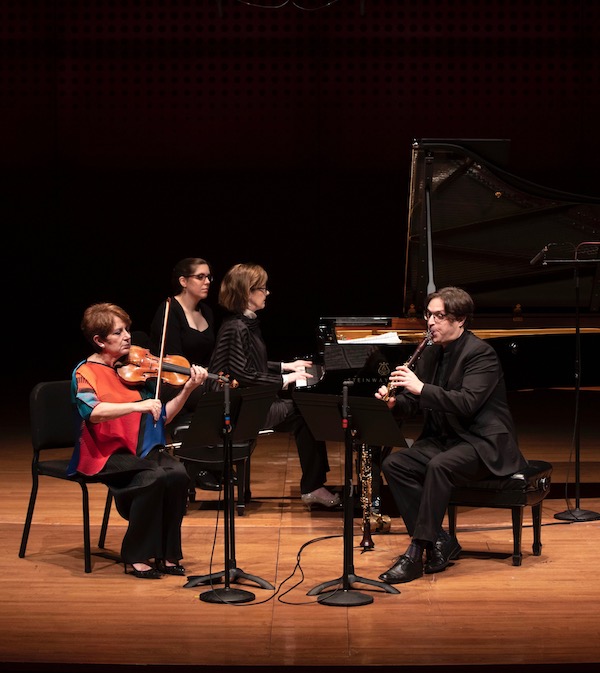McDermott and friends join forces for enjoyable trio program at CMS

Whoever in the Chamber Music Society of Lincoln Center’s head office is coming up with the titles to their concert programs certainly has an eye for something catchy, even when it’s slightly misleading—which is perhaps the essence of marketing.
Take Sunday’s matinee performance in Alice Tully Hall. The program carried the title “1918: Stravinsky’s The Soldier’s Tale.” Yes, the musicians did play a version of L’histoire du soldat which did premiere in 1918. But that was only a fraction of a concert that otherwise had nothing to do with Stravinsky nor the year 1918.
Whatever. Call it instead “Anne-Marie McDermott and Friends” or, better yet, “The Art of the Trio.” Smetana’s Piano Trio in G minor was the only one for the standard format of violin, cello, and piano. There was also clarinet, cello, and piano—Beethoven’s Op. 11 Trio in B-flat Major—and L’histoire in the composer’s reduction for violin, clarinet, and piano. Out of place thematically but wonderful musical was McDermott playing the first three of Mendelssohn’s Lieder ohne Worte, Op. 19a.
McDermott is one of the mainstays at CMS and a musician’s musician. She can seemingly play everything, and does so in a way that one notices her only through the music. All the articulations, phases, dynamics sound wonderful and musical, and inside all that is McDermott.
She was joined with the usual roster of equally fine musicians; violinist Ida Kavafian, cellist Gary Hoffman, and clarinetist Jose Franch-Ballester.
The title apart, this was a well-chosen program, a good balance of winners and surprises. Beethoven’s Op. 11 was one of the latter, a chamber work from the titan that few of the concert-goers Sunday had likely ever heard, making the experience something of a premiere.
Beethoven wrote this at the request of a Viennese clarinetist Joseph Bähr, who specifically asked for the last movement to use a popular tune from the time. One suspects those two elements are responsible for the convivial, even cheeky feeling. As heard Sunday, the musicians seem to be playing not only for each other but with each other, and that not only in the sense of ensemble unanimity—which was excellent in every configuration throughout the concert—but teasing and tweaking each other. That was in the spirit of the music, which sounds like Beethoven was tossing things out with the attitude of “How’d you like that one, Bähr?”
The trio version of L’histoire is also a relative rarity. Stravinsky arranged it in 1919, likely as a way to be able to make more money from the work, a thought never far in his thinking.
Like any arrangement of a well-known work, it loses some qualities while highlighting other details. Though scored for fewer instruments, moving so much of the music to the piano made for a thicker, heavier texture. This moved the experience away from the theatrical and more into chamber music, interplay between instruments rather than accompaniment for an actor. Franch-Ballester’s piping sound was unexpectedly intense, and the medley movement of Tango, Waltz, and Ragtime, was superb, not only a chance to hear the composer’s brilliant reinterpretation of the meaning of those styles, his prismatic rhythms, but also the alert ensemble playing. With Kavafian having much of the lead music, Franch-Ballester and McDermott played off her like dancers switching partners.
The second half opened with McDermott playing the Mendelssohn solo selections. Her transparency, her ideal judgement of rubato, the way she brought out the lyricism, produced a lovely glow from the stage. Right from the first notes, this was an entrancing performance, pushing away all other thoughts for the pure sound of the music, and one regretted that she was not scheduled to play the entirety of the work.
The Smetana trio was a powerful performance. Kavafian, Hoffman, and McDermott started off with the feeling of shoving a great weight forward. The effort did not at first fully mesh with the expression, it overshadowed the brooding anguish in the music, but the first quiet passages of the opening Moderato assai movement gave the musicians the opportunity to find the right emotional pitch to match their technique.
From that point on, the performance was scintillating; the second movement hinting at evocative memories, and the Presto finale hurtled along with the determination to break through to the last moment of transcendence.
Jeffrey Kahane plays the Goldberg Variations, 7:30 p.m., December 3, in Alice Tully Hall. chambermusicsociety.org






